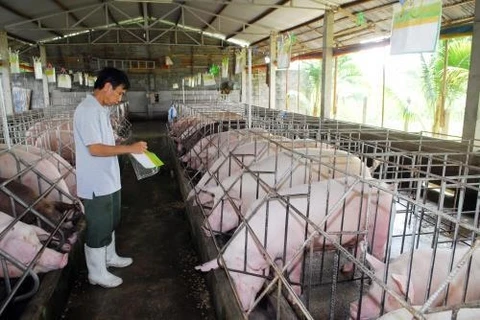Hanoi (VNS/VNA) – Many enterprises have started moving to the chilled meat sector, as it is expected to become a new consumer trend in the future domestically, according to experts.
Masan Group has built a meat processing complex in Ha Nam province with total investment of more than 1 trillion VND (43.2 USD), with capacity of 1.4 million pigs per year, equivalent to 140,000 tonnes of chilled meat.
Vietnamese people’s meat consumption habits will change so if there are good and safe products with competitive prices, they will buy, Matthys van der Lely, Masan Nutri-Science Corporation (MNS)’s managing director of meat business, was quoted by Phap luat thanh pho Ho Chi Minh (HCM City Law) newspaper as saying.
Meanwhile, a hi-tech pig slaughterhouse meeting international standards and run by Bien Dong DHS was inaugurated in the northern province of Nam Dinh last year with capacity of 300 pigs per hour.
Vissan has also started to develop chilled meat production.
Nguyen Xuan Cuong, minister of agriculture and rural development, said the development of chilled meat processing factories is a big change for Vietnam’s meat industry because chilled meat is not popular on the domestic market.
Therefore, Cuong said Vietnam recently issued a national standard for chilled production and trading, aiming to ensure food safety and hygiene for pork products that are consumed on the domestic market and exported.
"Chilled meat processing is part in the process of converting production from small scale to industrial processing scale with chain management, product traceability and meeting export criteria," he said.
Agricultural expert Vo Tong Xuan said production of chilled meat was one way to better ensure food safety and export pork. That would help the domestic livestock sector not fall into stagnation as has happened over the years. However, time and communications campaigns are needed to change consumers’ habit of using warm meat, Xuan said.
In addition, price is also an obstacle because at present, the selling price of chilled meat in supermarkets and shops is still 20-30 percent higher than warm meat from markets, according to experts.
The product needs a reasonable price to encourage local consumers to buy more.
According to the Ministry of Agriculture and Rural Development (MARD), pork production reached 3.8 million tonnes in 2018, up 2.2 percent year on year.
Most Vietnamese pork is used for domestic consumption while export volume is very small.
Now, Vietnam is the seventh largest producer of pork in the world, after China, the US, Germany, Spain, Brazil and Russia.
The Vietnamese market is dominated by fresh meat, or warm meat, which is sold soon after slaughter without cold storage. Fresh pork does not require large investment in storage and is preferred by local consumers even though it is the type of meat most likely to be sold without preservation and from an unknown source.
The MARD estimates that up to 90 percent of pork sold on the domestic market is warm pork.
In contrast to warm pork, chilled meat is frozen at minus 18 degrees Celsius and preserved for a long time before sale. However, this kind of food requires consumers to have knowledge to prepare it, especially the right defrosting technique to ensure quality.-VNS/VNA
VNA
























